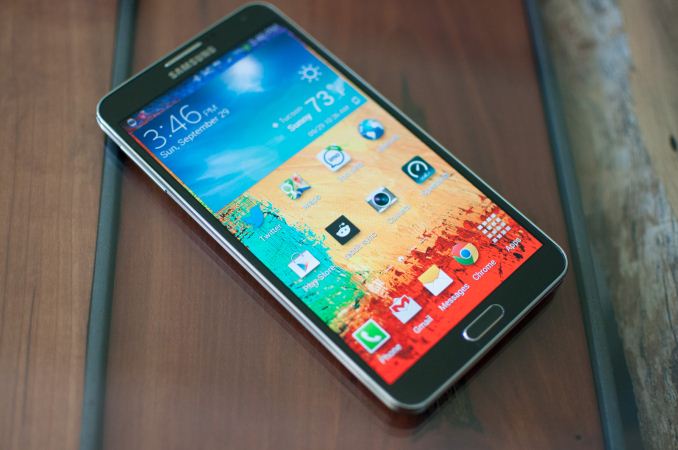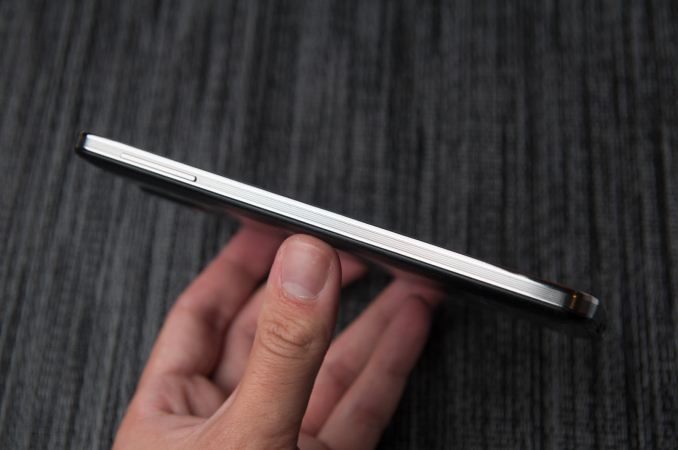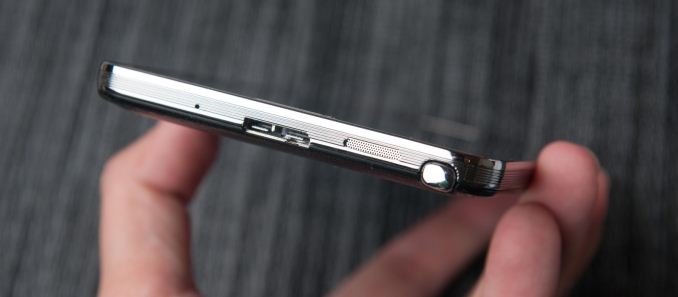Samsung Galaxy Note 3 Review
by Brian Klug on October 1, 2013 9:00 AM EST- Posted in
- Smartphones
- Samsung
- Mobile
- Android 4.3
- galaxy note 3

I still remember the first time I held the original Galaxy Note. At that point in time it wasn’t really obvious just how critical larger-display smartphones were going to be in the future, nor just how close the smartphone market was to becoming a mature one. In a mature market it’s all about filling in the niches, something Samsung has been doing since the very beginning by casting a very large form factor net with its lineup of android devices.
I remember being intrigued with the original Note more for the active digitizer feature (S-Pen) than the large display. It was during the height of the draw something craze, and having a stylus seemed like a logical advantage. Two years I lean the other way entirely, it’s that bigger display that makes me interested in the form factor not just as a curiosity but as something I actually want to use daily.
This is now Samsung’s third Galaxy Note, and as the adage goes hopefully third time is indeed a charm. Not that the first two weren’t wildly popular to begin with, either.
The Note 3 is obviously an iterative product with iterative improvements. The basic formula of the Note is unchanged - huge display, bumped specs versus the S series flagship, and active digitizer pen. The improvements this time are bigger display while making the overall device dimensions smaller, much faster SoC, higher resolution display, better camera, and all the improvements around the edges you’d expect (802.11ac, USB 3.0, IR).
I always start out by talking about the industrial design, appearance, and feel of devices, and won’t change that with the Note 3. Let’s just say it - the design of the Note 3 honestly isn’t a significant departure from Samsung’s norm. Then again nobody should’ve expected a huge departure to begin with.
Whereas the Note 2 felt and looked a lot like a blown up SGS3, the Note 3 is likewise a bit like a larger SGS4, although I honestly see bits of SGS2 in it. The front is home to the huge display, the same kind of earpiece grille we always see from Samsung, front facing camera, physical home button, and capacitive menu and back buttons.
The edge of the Note 3 is ringed with the familiar chrome, although this time there’s a ridge which makes it more grippy. With bigger phones making the edges less slippery is important, the Note 3 hits the mark here nicely.
All the buttons are also in the usual places for Samsung, and feel great. Power is easy to get to, the volume rocker as well is nicely positioned.
Headphone jack and the IR port are up top, along with one of the 3 microphones used for noise cancelation on the Note 3.
There’s another microphone on the bottom right of the device, and the third is at the bottom to the left of the microUSB 3.0 type B connector jack.
There’s been a lot of talk about the presence of USB 3.0, even though the micro B connector type has been around for considerable time already and in a ton of devices. The Note 3 just has the misfortune of apparently being many people’s first exposure to the connector, whose awkward double lobed shape gives it forwards compatibility with microUSB 2.0. The rightmost region is just the familiar microUSB 2.0 connector, the left contains the pins for SuperSpeed signaling for 3.0. Plug something into the right 2.0 jack and you get 2.0 speed for transfers and charging. 3.0 at present should give you faster transfer rate (it doesn't in practice as you'll soon see), and eventually faster charging, but the Note 3 continues to use Samsung’s 2.0 amp charging spec and rate, but more on that later.
|
Samsung Galaxy Note 3 (T-Mobile SM-N900T) |
|
| SoC |
2.3 GHz Qualcomm Snapdragon 800 (MSM8974) 4x Krait 400 @ 2.3 GHz, Adreno 330 at 450 MHz |
| Display | 5.7-inch Super AMOLED (1080p) |
| RAM | 3 GB LPDDR3 |
| WiFi | 802.11a/b/g/n/ac (BCM4339) + BT 4.0 |
| Storage | 32 / 64 GB + microSDXC (up to 64 GB) |
| I/O | microUSB 3.0, MHL 2.0, IR LED (remote), NFC |
| OS | Android 4.3 |
| Battery | 3200 mAh, 3.8V, 12.1 Whr |
| Size / Mass | 151.2 x 79.2 x 8.3mm, 168g |
| Camera |
13 MP w/AF, LED (Rear Facing) – 1080p60, 720p120, 4k30 2 MP (Front Facing) |
Whereas most of the Note 3 is par for the course for Samsung device design, the backside is something different entirely. Instead of the slick plastic that we normally get out of the Korean handset makers, the Note 3 backside material is plastic, textured to look like a leather bound book complete with faux stitching, and in the case of the black color, topped with a somewhat grippy rubbery finish. The white model doesn’t get that rubbery finish, and instead just feels like somewhat roughly textured plastic with the same faux leather pattern. I’ve held pleather, fake leather, and real leather, and this frankly isn’t any of that. It’s still injection molded plastic, but this time patterned so it looks vaguely leather.
Samsung does deserve kudos for not just giving us another slimy-backed phone with a glossy plastic battery cover, however. I have to admit I do like the rubber finish on the black Note 3 I was sampled, as the white one feels significantly different as it lacks that finish. The only downside is that it does pick up and show hand grease, whereas the white one handles it better. I could do without the fake stitching though.
I’ve been avoiding the discussion about the size of the Note 3 and whether it’s too big or too much. I’ve addressed this before in the Note 2 review, and I’d encourage you to read page 2’s “using a phablet” section, since the Note 3 is essentially the same situation, since it’s the same form factor. I can definitely use the form factor just fine, and the Note 3 comfortably. With the swipe keyboards that are popular now (I just use the stock Google Keyboard) I can even type one handed without much effort. In fact I’ve written a huge chunk of this review on the Note 3 in Draft, some of it one-handed.
Hands vary in size, and what size device is “best” for someone is really just a matter of personal taste. Some people are clamoring for smaller devices, others want bigger - as this market matures, success for OEMs will mean a diverse portfolio filling in all the obvious form factors.
More and more I’m starting to think the width of devices is the pain point that causes real fatigue, and edge bezel thickness. The Note 3 does very well here compared to its predecessor because it’s thinner, and lighter. In fact, you could pretty much sum up the Note 3 with – thinner, lighter, faster, oh and it has a bigger display at the same time.
|
Galaxy Note 3 (T-Mobile) |
Galaxy Note 2 (T-Mobile) |
Galaxy Note (AT&T) |
|
| Height | 151.2 mm | 151.1 mm | 146.85 mm |
| Width | 79.2 mm | 80.5 mm | 82.95 mm |
| Thickness | 8.3 mm | 9.4 mm | 9.65 mm |
| Mass | 168 grams | 180 grams | 178 grams |
| Display Size | 5.7-inch | 5.5-inches | 5.3-inches |
| Display Resolution | 1920 x 1080 | 1280 x 720 | 1280 x 800 |
| SoC | 2.3 GHz Snapdragon 800 (4x Krait 400) | 1.6 GHz Samsung Exynos 4412 (4x Cortex A9) |
1.4 GHz Qualcomm Snapdragon (APQ8060 - 2x Scorpion) |
| Camera | 13 MP with LED | 8 MP with LED | 8 MP with LED |
| Battery | 3200 mAh, 3.8V, 12.16 Whr | 3100 mAh, 3.8V, 11.78 Whr | 2500 mAh, 3.7V, 9.25 Whr |
I really want to use the Note 3 a lot more this time, since having more display real estate does make me feel like I can accomplish more. Obviously multimedia content also benefits from a larger viewport as well. Since I haven’t ever really been a tablet person, larger phones seem like a logical tradeoff.
Honestly the Note 3 feels better than its predecessor, and the biggest reasons for that are the textured rubberized back, grippier textured edge, thinner body, and thinner width. Oh and there’s no creakiness or build quality issues to speak of, in spite of being so large the Note 3 is very rigid and solid.




















302 Comments
View All Comments
doobydoo - Saturday, October 19, 2013 - link
'The chipset IS in fact performing as the benchmark indicates'No, it isn't. The chipset CAN'T reach the same speeds for any non-benchmark application, for reasons such as battery life and heat.
Your argument that bickering about performance is redundant is also stupid, because if it was, Samsung wouldn't feel the need to cheat them.
esterhasz - Wednesday, October 2, 2013 - link
I would be much in favor of standardized qualitative testing. Have a set five people panel use the phone for a day in their normal workflow and use a questionnaire for performance rating. Sure it's subjective, but users are subjects last time I looked.Demigod79 - Thursday, October 3, 2013 - link
Although I too would like to a cheat vs non-cheat result in benchmarks (perhaps mark out cheat results in a different color or something), Anand did state clearly that this was cheating. There was no glossing over this fact, he laid it out explicitly and said that he wanted this practice to stop (for all OEMs that do it).He also mentioned that it's unlikely that OEMs will stop doing this. It's easy for the OEMs to do and makes their products look better (and frankly, it's only technical geeks who care about things like this, and we only represent a tiny segment of smartphone buyers). If it sells more products, then they will do it (although I find it about as frivolous as the Nvidia and then-ATI battle to have the fastest GPU, simply for the sake of wearing the performance crown for a couple of months).
That being said though, this is benchmarks we're talking about here. Benchmarks do not represent real-world usage, and never have. All you have to do is look at 3DMark, which was criticized for some time as being too artificial (CPU speeds hardly mattered, whereas in real life CPU speed matters greatly). Benchmarks are, by nature, highly artificial tests meant to measure performance in a specific area. Although you can complain that cheating in benchmarks give a false impression of performance compared to other devices, you cannot say that such cheating misrepresents real-world usage since it doesn't represent real-world usage in the first place.
DanNeely - Tuesday, October 1, 2013 - link
"The impact is likely small since most of these tests should drive CPU frequencies to their max state regardless (at least on the CPU side), but I'm going to make it a point to call out this behavior whenever I see it from now on."Unfortunately this isn't the case. By decompiling benchmarks and changing package names to disable the cheat function Ars Technica discovered that the GN3 is inflating benchmark scores by 20-50%. Most got a 20% boost; Linpack was an outlier at 50%.
http://arstechnica.com/gadgets/2013/10/galaxy-note...
Anand Lal Shimpi - Tuesday, October 1, 2013 - link
This is unfortunately something we've seen on a lot of devices, not just Samsung. Google Experience devices aren't affected, but we've seen it on the SGS4 and HTC One among others.Linpack isn't a very consistent test and it's too short to drive frequencies up consistently, which is why I'm guessing it's an outlier. The 20% end is higher than expected, it's entirely possible that Samsung is lifting a thermal limit as well as driving CPU frequencies up.
I don't like any of it and I do want to see companies stop doing it. I was hoping we would see an end to it with the Note 3 but it looks like that was wishful thinking.
Take care,
Anand
Wojciech - Tuesday, October 1, 2013 - link
Have you thought about doing an article about 'fixing' benchmark scores by other OEM's?If you're saying that HTC is doing the same with One then maybe LG is doing something similar and maybe even Sony.
Normal behavior by Google experience devices would explain often lower scores than customized devices running on the same hardware platform.
Don't you think that would be an interesting topic to examine?
Right now I fear that more and more OEM's are going to start doing the same thing and the whole 'benchmark to determine real life performance' will be completely lost.
xype - Wednesday, October 2, 2013 - link
You don't like any of it? But you still put up the graphs and numbers with an "Oh my."? People come here because AnandTech has a reputation of providing in-depth, honest reviews. Most people scan the text and go right to the graphs. Their takeaway will be a marketing lie that you didn't bother to correct because "A lot of companies do that."? Seriously?Spunjji - Tuesday, October 8, 2013 - link
If you skim the text and go to the graphs you will never, EVER get a representative review of anything. People come to Anandtech for analysis and they got that with this review. If they missed that then they might as well have gone to any of the other sites.doobydoo - Saturday, October 19, 2013 - link
Na, most people come to Anandtech because they know the graphics will have been performed in an objective and logical way. I would bet that the vast majority of readers don't read the text associated with such images.And that doesn't mean that they should go to other sites.
Squuiid - Tuesday, October 1, 2013 - link
"It's also interesting to note that the Galaxy Note 3 appears to outperform all other Snapdragon 800 smartphones we've tested thus far. There's a couple of potential explanations here."You missed an explanation: Samsung cheat.
From Ars:
"The two functions applied to this list seem to be "PACKAGES_FOR_BOOST_ALL_ADJUSTMENT" which is no doubt the CPU booster, and "PACKAGES_FOR_LCD_FRAME_RATE_ADJUSTMENT" which makes it sound like they are also changing the display frame rate."